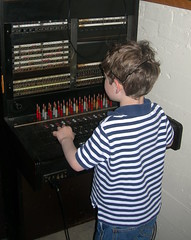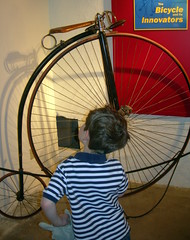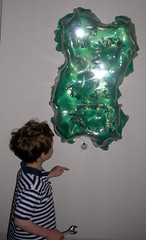 As a GeekDad, I often focus on high-tech tools and the latest, shiny gadgets. If I want my GeekSon and GeekDaughter to appreciate the the digital age, I think it makes sense to also show them low-tech, no-tech, and pre-tech. So we went to the Charles River Museum of Industry & Innovation to see what high-tech looked like in the 1800's.
As a GeekDad, I often focus on high-tech tools and the latest, shiny gadgets. If I want my GeekSon and GeekDaughter to appreciate the the digital age, I think it makes sense to also show them low-tech, no-tech, and pre-tech. So we went to the Charles River Museum of Industry & Innovation to see what high-tech looked like in the 1800's.
The Charles River Museum of Industry & Innovation is located on the scenic banks of the Charles River in the historic 1814 Boston Manufacturing Company textile mill. (It is listed on the National Register of Historic Places as America's first factory.) The museum starts with the story of Francis Cabot Lowell, who secretly memorized plans for English power looms. Upon his return to Boston in 1813, he built this mill as the first in the U.S. where all operations for converting raw cotton into finished cloth could be performed in one mill building. In the 1800's, a network of rivers was the key to technology. The power of the flowing water drove the looms and machinery that were once in the museum's building.
What would my GeekSon think about the Charles River Museum of Industry & Innovation?
 The history was nice, but the GeekSon wanted the machines. And he got them. The first floor of the museum has a bank of tools powered in the old-school manner by overhead drive shafts and belts. A museum employee came over and gave him the experience of the room-shaking roar of the vintage machinery in operation. The museum no longer relies on the power of the river, just a simple electrical motor. That motor fired up the overhead belts. To work the machines, you use a big wooden lever to slide the belt from the dummy pulley to the power pulley. He loved seeing the drill put holes in a scrap of wood. We did the same with a metal planer, shaving curls of metal from the metal blank.
The history was nice, but the GeekSon wanted the machines. And he got them. The first floor of the museum has a bank of tools powered in the old-school manner by overhead drive shafts and belts. A museum employee came over and gave him the experience of the room-shaking roar of the vintage machinery in operation. The museum no longer relies on the power of the river, just a simple electrical motor. That motor fired up the overhead belts. To work the machines, you use a big wooden lever to slide the belt from the dummy pulley to the power pulley. He loved seeing the drill put holes in a scrap of wood. We did the same with a metal planer, shaving curls of metal from the metal blank.
Also on the first floor was a bunch of steam engines, with moving flywheels. Little boys love turning wheels. There were several attached to cutaway engines for him to turn so he could watch the parts move.
There was an antique fire engine (Waltham's first) to climb on, along with a fire chief's helmet. Some model trains and other miscellaneous displays filled up the first floor. The museum hosts a virtual tour of their first floor if you want to take a look.
The museum has an exhibit showing the old phone system with an old phone booth and switchboard. That kept my GeekSon occupied for a long time. He loved connecting those wires together and plugging them in. I explained how the telephone switchboard worked and that this is what used to be required to make a phone call. I am not sure he got it. I think he just liked plugging the wires in, pulling them out and saying "Hello, operator." (The telephone exhibit was my his favorite.)
We went upstairs to check out the watch and precision tools displays. My GeekSon was fascinated with the tiny parts, tools, and strange looking devices. The displays were about the Waltham Watch Company, which produced more than 40 million watches during 100 years of operation. Waltham became known as the "Watch City." But looking at stuff can only keep a 5-year old occupied for so long.
In addition to the museum's own exhibits they also have extra space for other exhibits. We got to see "The Wheelman's Machine, the Bicycle and its Innovators" chronicling the bicycle's first century of development. Since he just got his first bike, I thought he might get a kick out of a wooden draisine, a bone shaker or a high wheel bike.
I was wrong. Apparently, little boys don't want to see bikes they can't touch.
A second exhibit on display was Another Side of In. This is an interactive multimedia art installation created by a collaboration among: Mike Gordon, of the band Phish who created the music; his mother Marjorie Minkin, who developed a unique process for making sculptural paintings with molded Lexan and created the sculptures while listening to her son's sounds; and Jamie Robertson, who designed and built the electronics. The pieces interact with the viewer.
As you approach and move around each piece it lights up and makes sounds. My GeekSon loved moving around the pieces, seeing them light up and make sounds. It was like the keyboard in the movie BIG.
The final verdict about the museum comes from the mouth of my GeekSon: "Its kind of cool, if you ask me."
Wired:
Price. $5 for adults and kids five and over; kids under five are free.
Setting. The roar of the Moody Street Dam is a few hundred feet away and the Charles River rushes past the front door. It's a great place to have a picnic after going through the museum.
Tired:
Limited hours. Only open 10-5 Thursday through Saturday
Limited signage. The museum is hard to find unless you know it's there.
Expired:
Lots of stairs to get in. (The GeekDaughter came along with us in her stroller.) I'm sure there was an alternative entrance around somewhere, but I would expect a ramp.
All photos are by Doug Cornelius.


